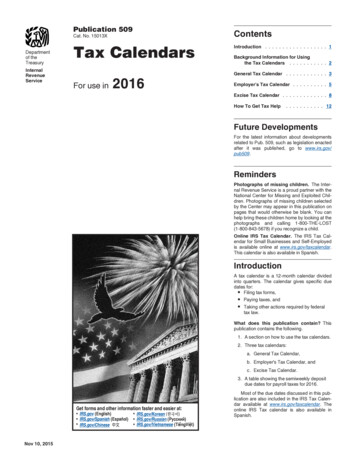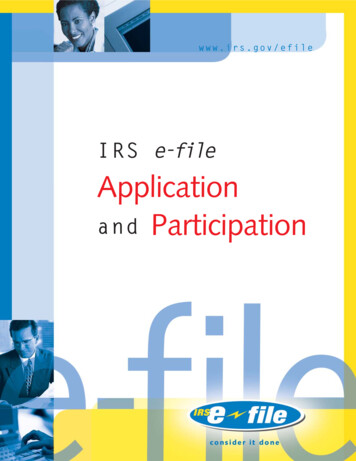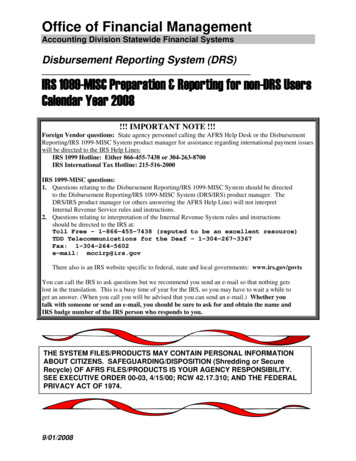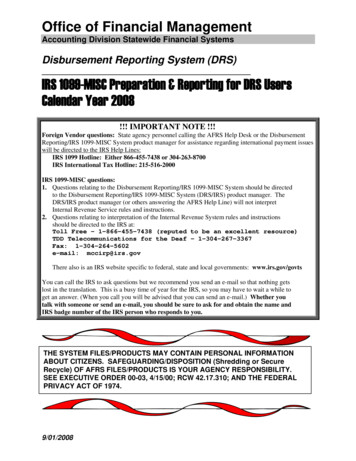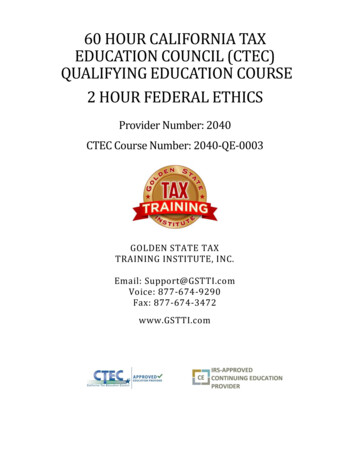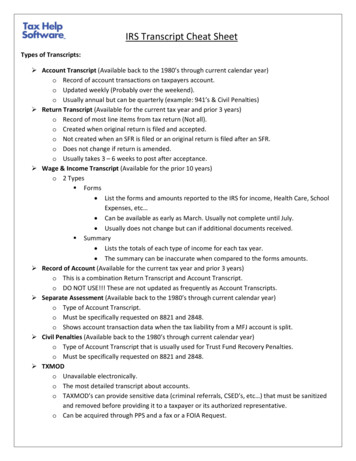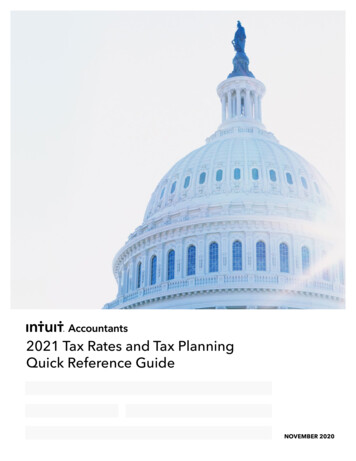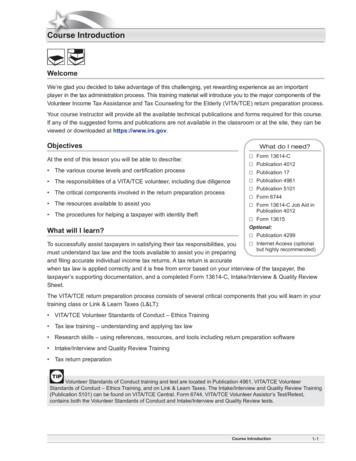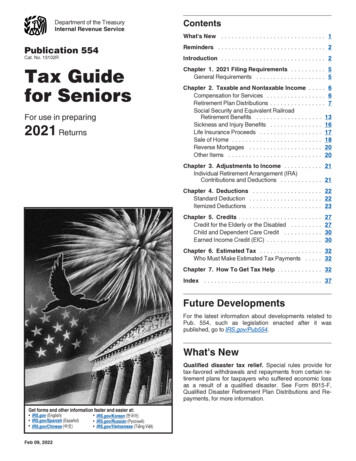
Transcription
Department of the TreasuryInternal Revenue ServicePublication 554ContentsWhat's New . . . . . . . . . . . . . . . . . . . . . . . . . . . . . . 1Reminders . . . . . . . . . . . . . . . . . . . . . . . . . . . . . . . 2Cat. No. 15102RIntroduction . . . . . . . . . . . . . . . . . . . . . . . . . . . . . . 2Tax Guidefor SeniorsChapter 1. 2021 Filing Requirements . . . . . . . . . . 5General Requirements . . . . . . . . . . . . . . . . . . . . 5For use in preparing2021 ReturnsChapter 2. Taxable and Nontaxable IncomeCompensation for Services . . . . . . . . . . . .Retirement Plan Distributions . . . . . . . . . . .Social Security and Equivalent RailroadRetirement Benefits . . . . . . . . . . . . . . .Sickness and Injury Benefits . . . . . . . . . . .Life Insurance Proceeds . . . . . . . . . . . . . .Sale of Home . . . . . . . . . . . . . . . . . . . . . .Reverse Mortgages . . . . . . . . . . . . . . . . .Other Items . . . . . . . . . . . . . . . . . . . . . . . 6. 6. 7.131617182020Chapter 3. Adjustments to Income . . . . . . . . . . . 21Individual Retirement Arrangement (IRA)Contributions and Deductions . . . . . . . . . . . . 21Chapter 4. Deductions . . . . . . . . . . . . . . . . . . . . 22Standard Deduction . . . . . . . . . . . . . . . . . . . . . 22Itemized Deductions . . . . . . . . . . . . . . . . . . . . . 23Chapter 5. Credits . . . . . . . . . . . . . .Credit for the Elderly or the DisabledChild and Dependent Care Credit .Earned Income Credit (EIC) . . . . . .27273030Chapter 6. Estimated Tax . . . . . . . . . . . . . . . . . . 32Who Must Make Estimated Tax Payments . . . . . 32Chapter 7. How To Get Tax Help . . . . . . . . . . . . . 32Index . . . . . . . . . . . . . . . . . . . . . . . . . . . . . . . . . . 37Future DevelopmentsFor the latest information about developments related toPub. 554, such as legislation enacted after it waspublished, go to IRS.gov/Pub554.What's NewQualified disaster tax relief. Special rules provide fortax-favored withdrawals and repayments from certain retirement plans for taxpayers who suffered economic lossas a result of a qualified disaster. See Form 8915-F,Qualified Disaster Retirement Plan Distributions and Repayments, for more information.Get forms and other information faster and easier at: IRS.gov (English) IRS.gov/Spanish (Español) IRS.gov/Chinese (中文)Feb 09, 2022 IRS.gov/Korean (한국어) IRS.gov/Russian (Pусский) IRS.gov/Vietnamese (Tiếng Việt)
Standard deduction amount increased. For 2021, thestandard deduction amount has been increased for all filers. The amounts are: Single or Married filing separately— 12,550. Married filing jointly or Qualifying widow(er)— 25,100. Head of household— 18,800.Alternative minimum tax exemption increased. TheAMT exemption amount has increased to 73,600( 114,600 if married filing jointly or qualifying widow(er); 57,300 if married filing separately).Earned income credit. The maximum amount of incomeyou can earn and still get the credit has increased. Youmay be able to take the credit if you earn less than: 21,430 ( 27,380 if married filing jointly), don't have aqualifying child, and are at least 25 years old and under age 65; 42,158 ( 48,108 if married filing jointly), and youhave one qualifying child; 47,915 ( 53,865 if married filing jointly), and youhave two qualifying children; or 51,464 ( 57,414 if married filing jointly), and youhave three or more qualifying children.For more information, see Earned Income Credit, later.Standard mileage rate. For 2021, the standard mileagerate allowed for operating expenses for a car when youuse it for medical reasons decreased to 16 cents a mile.RemindersMaximum age for traditional IRA contributions. Theage restriction for contributions to a traditional IRA hasbeen eliminated.Increase in age for mandatory distributions. Individuals who reach age 701/2 on January 1, 2021, or later maydelay distributions until April 1 of the year following theyear in which they turn age 72.Form 1040-SR. Form 1040-SR, U.S. Tax Return for Seniors, was introduced in 2019. You can use this form if youare age 65 or older at the end of 2021. The form generallymirrors Form 1040. However, the Form 1040-SR haslarger text and some helpful tips for older taxpayers. Seethe Instructions for Form 1040 for more information.Tax return preparers. Choose your preparer carefully. Ifyou pay someone to prepare your return, the preparer isrequired, under the law, to sign the return and fill in theother blanks in the Paid Preparer Use Only area of yourreturn. Remember, however, that you are still responsiblefor the accuracy of every item entered on your return. Ifthere is any underpayment, you are responsible for payingit, plus any interest and penalty that may be due.Third party designee. You can check the “Yes” box inthe Third Party Designee area of your return to authorizethe IRS to discuss your return with your preparer, a friend,a family member, or any other person you choose. Thisallows the IRS to call the person you identified as yourPage 2designee to answer any questions that may arise duringthe processing of your return. It also allows your designeeto perform certain actions. See your income tax return instructions for details.Employment tax withholding. Your wages are subjectto withholding for income tax, social security tax, andMedicare tax even if you are receiving social security benefits.Social security benefits information. Social securitybeneficiaries may quickly and easily obtain various information from the Social Security Administration’s (SSA’s)website with a my Social Security account, including getting a replacement SSA-1099 or SSA-1042S. For more information, go to SSA.gov/myaccount. See Obtaining social security information, later.Photographs of missing children. The Internal Revenue Service is a proud partner with the National Center forMissing & Exploited Children (NCMEC). Photographs ofmissing children selected by the Center may appear inthis publication on pages that would otherwise be blank.You can help bring these children home by looking at thephotographs and calling 800-THE-LOST (800-843-5678)if you recognize a child.IntroductionThe purpose of this publication is to provide a generaloverview of selected topics that are of interest to older taxpayers. This publication will help you determine if youneed to file a return and, if so, what items to report on yourreturn. Each topic is discussed only briefly, so you will findreferences to other free IRS publications that providemore detail on these topics if you need it.Table I has a list of questions you may have about filingyour federal tax return. To the right of each question is thelocation of the answer in this publication. Also, at the backof this publication, there is an index to help you search forthe topic you need.While most federal income tax laws apply equally to alltaxpayers, regardless of age, there are some provisionsthat give special treatment to older taxpayers. The following are some examples. Higher gross income threshold for filing. Youmust be age 65 or older at the end of the year to getthis benefit. You are considered age 65 on the day before your 65th birthday. Therefore, you are consideredage 65 at the end of the year if your 65th birthday is onor before January 1 of the following year. Higher standard deduction. If you don't itemize de-ductions, you are entitled to a higher standard deduction if you are age 65 or older at the end of the year.You are considered age 65 at the end of the year ifyour 65th birthday is on or before January 1 of the following year. Credit for the elderly or the disabled. If you qualify,you may benefit from the credit for the elderly or thedisabled. To determine if you qualify and how to figurePublication 554 (2021)
this credit, see Credit for the Elderly or the Disabled,later.Return preparation assistance. The IRS wants to makeit easier for you to file your federal tax return. You may findit helpful to visit a Volunteer Income Tax Assistance(VITA), Tax Counseling for the Elderly (TCE), or AmericanAssociation of Retired Persons (AARP) Tax-Aide site nearyou.Volunteer Income Tax Assistance and Tax Counseling for the Elderly. These programs provide freehelp for low-income taxpayers and taxpayers age 60 orolder to prepare and file their returns. For the VITA/TCEsite nearest you, contact your local IRS office. For moreinformation, see Preparing and filing your tax return underHow To Get Tax Help.AARP Tax-Aide. AARP Foundation Tax-Aide offersfree tax preparation and has more than 5,000 locations inneighborhood libraries, malls, banks, community centers,and senior centers annually during the filing season. 77) for more information.Comments and suggestions. We welcome your comments about this publication and suggestions for futureeditions.You can send us comments through IRS.gov/FormComments. Or, you can write to the Internal Revenue Service, Tax Forms and Publications, 1111 Constitution Ave. NW, IR-6526, Washington, DC 20224.Publication 554 (2021)Although we can’t respond individually to each comment received, we do appreciate your feedback and willconsider your comments and suggestions as we reviseour tax forms, instructions, and publications. Don’t sendtax questions, tax returns, or payments to the above address.Getting answers to your tax questions. If you havea tax question not answered by this publication or the HowTo Get Tax Help section at the end of this publication, goto the IRS Interactive Tax Assistant page at IRS.gov/Help/ITA where you can find topics by using the searchfeature or viewing the categories listed.Getting tax forms, instructions, and publications.Go to IRS.gov/Forms to download current and prior-yearforms, instructions, and publications.Ordering tax forms, instructions, and publications.Go to IRS.gov/OrderForms to order current forms, instructions, and publications; call 800-829-3676 to orderprior-year forms and instructions. The IRS will processyour order for forms and publications as soon as possible.Don’t resubmit requests you’ve already sent us. You canget forms and publications faster online.Page 3
Table I. What You Should Know About Federal TaxesNote. The following is a list of questions you may have about filling out your federal income tax return.To the right of each question is the location of the answer in this publication.What I Should KnowWhere To Find the AnswerDo I need to file a return?See chapter 1.Is my income taxable or nontaxable?If it is nontaxable, must I still report it?How do I report benefits I received from the SocialSecurity Administration or the Railroad Retirement Board?Are these benefits taxable?Must I report the sale of my home?If I had a gain, is any part of it taxable?See chapter 2.See Social Security and Equivalent Railroad RetirementBenefits in chapter 2.See Sale of Home in chapter 2.What are some of the items that I can deduct to reduce myincome?See chapters 3 and 4.How do I report the amounts I set aside for my IRA?See Individual Retirement Arrangement Contributionsand Deductions in chapter 3.Would it be better for me to claim the standard deductionor itemize my deductions?See chapter 4.What are some of the credits I can claim to reduce my tax?See chapter 5 for discussions on the credit for the elderlyor the disabled, the child and dependent care credit, andthe earned income credit.Must I make estimated tax payments?See chapter 6.How do I contact the IRS or get more information?See chapter 7.Page 4Publication 554 (2021)
1.2021 Filing RequirementsIf income tax was withheld from your pay, or if you qualifyfor a refundable credit (such as the earned income credit,the additional child tax credit, or the American opportunitycredit), you should file a return to get a refund even if youaren't otherwise required to file a return.Don't file a federal income tax return if you don'tTIP meet the filing requirements and aren't due a re-fund. If you need assistance to determine if youneed to file a federal income tax return for 2021, go toIRS.gov/ITA and use the Interactive Tax Assistant (ITA).General RequirementsIf you are a U.S. citizen or resident alien, you must file areturn if your gross income for the year was at least theamount shown on the appropriate line in Table 1-1. Forother filing requirements, see your tax return instructionsor Pub. 501, Dependents, Standard Deduction, and FilingInformation. If you were a nonresident alien at any timeduring the year, the filing requirements that apply to youmay be different from those that apply to U.S. citizens.See Pub. 519, U.S. Tax Guide for Aliens.Gross income. Gross income is all income you receivein the form of money, goods, property, and services thatisn't exempt from tax. If you are married and live with yourspouse in a community property state, half of any incomedefined by state law as community income may be considered yours. States with community property laws include Arizona, California, Idaho, Louisiana, Nevada, NewMexico, Texas, Washington, and Wisconsin. A registereddomestic partner in Nevada, Washington, or Californiamust generally report half the combined community income of the individual and his or her domestic partner. Formore information about community property, see Pub.555, Community Property.For more information on what to include in gross income, see chapter 2.Table 1-1. 2021 Filing Requirements Chart for Most TaxpayersNote. You must file a return if your gross income was at least the amount shown in the last column.AND at the end of 2021you were . . .*THEN file a return if yourgross income** was at least. . .Singleunder 65 12,55065 or older 14,250under 65 18,80065 or older 20,500under 65 (both spouses) 25,10065 or older (one spouse) 26,45065 or older (both spouses) 27,800.IF your filing status is. . .Head of householdMarried filing jointly***Married filing separatelyany ageQualifying widow(er)under 65 25,10065 or older 26,450****** 5If you were born before January 2, 1957, you are considered to be age 65 or older at the end of 2021. (If your spousedied in 2021 or if you are preparing a return for someone who died in 2021, see Pub. 501.)Gross income means all income you receive in the form of money, goods, property, and services that isn't exempt fromtax, including any income from sources outside the United States or from the sale of your main home (even if you canexclude part or all of it). It also includes gains, but not losses, reported on Form 8949 or Schedule D. Gross income froma business means, for example, the amount on Schedule C, line 7, or Schedule F, line 9. But, in figuring gross income,don't reduce your income by any losses, including any loss on Schedule C, line 7, or Schedule F, line 9. Don't includeany social security benefits unless (a) you are married filing separately and you lived with your spouse at any time in2021, or (b) one-half of your social security benefits plus your other gross income and any tax-exempt interest is morethan 25,000 ( 32,000 if married filing jointly). If (a) or (b) applies, see the Instructions for Form 1040 or Pub. 915, SocialSecurity and Equivalent Railroad Retirement Benefits, to figure the taxable part of social security benefits you mustinclude in gross income.If you didn't live with your spouse at the end of 2021 (or on the date your spouse died) and your gross income was atleast 5, you must file a return regardless of your age.Chapter 12021 Filing RequirementsPage 5
Self-employed persons. If you are self-employed in abusiness that provides services (where the production,purchase, or sale of merchandise isn't an income-producing factor), gross income from that business is the grossreceipts. If you are self-employed in a business involvingmanufacturing, merchandising, or mining, gross incomefrom that business is the total sales minus the cost ofgoods sold. In either case, you must add any income frominvestments and from incidental or outside operations orsources. See Pub. 334, Tax Guide for Small Business, formore information.Dependents. If you could be claimed as a dependent byanother taxpayer (that is, you meet the dependency testsin Pub. 501), special filing requirements apply. See Pub.501.DecedentsA personal representative of a decedent's estate can bean executor, administrator, or anyone who is in charge ofthe decedent's property.If you are acting as the personal representative of aperson who died during the year, you may have to file afinal return for that decedent. You also have other duties,such as notifying the IRS that you are acting as the personal representative. Form 56, Notice Concerning Fiduciary Relationship, is available for this purpose.When you file a return for the decedent, either as thepersonal representative or as the surviving spouse, youshould enter “DECEASED,” the decedent's name, and thedate of death across the top of the tax return.If no personal representative has been appointed bythe due date for filing the return, the surviving spouse (ona joint return) should sign the return and enter in the signature area “Filing as surviving spouse.”For more information, see Pub. 559, Survivors, Executors, and Administrators.Surviving spouse. If you are the surviving spouse, theyear your spouse died is the last year for which you canfile a joint return with that spouse. After that, if you don'tremarry, you must file as a qualifying widow(er), head ofhousehold, or single. For more information about each ofthese filing statuses, see Pub. 501.If you remarry before the end of the year in which yourspouse died, a final joint return with the deceased spousecan't be filed. You can, however, file a joint return withyour new spouse. In that case, the filing status of your deceased spouse for his or her final return is married filingseparately.The level of income that requires you to file an income tax return changes when your filing statusCAUTION changes (see Table 1-1). Even if you and your deceased spouse weren't required to file a return for severalyears, you may have to file a return for tax years after theyear of death. For example, if your filing status changesfrom filing jointly in 2020 to single in 2021 because of thedeath of your spouse, and your gross income is 17,500!Page 6Chapter 2Taxable and Nontaxable Incomefor both years, you must file a return for 2021 even thoughyou didn't have to file a return for 2020.2.Taxable and NontaxableIncomeGenerally, income is taxable unless it is specifically exempt (not taxed) by law. Your taxable income may includecompensation for services, interest, dividends, rents, royalties, income from partnerships, estate or trust income,gain from sales or exchanges of property, and businessincome of all kinds.Under special provisions of the law, certain items are partially or fully exempt from tax. Provisions that are of special interest to older taxpayers are discussed in this chapter.Compensation for ServicesGenerally, you must include in gross income everythingyou receive in payment for personal services. In additionto wages, salaries, commissions, fees, and tips, this includes other forms of compensation such as fringe benefits and stock options.You don’t need to receive the compensation in cash forit to be taxable. Payments you receive in the form ofgoods or services must generally be included in gross income at their fair market value.Volunteer work. Don't include in your gross incomeamounts you receive for supportive services or reimbursements for out-of-pocket expenses under any of the following volunteer programs. Retired Senior Volunteer Program (RSVP).Foster Grandparent Program.Senior Companion Program.Service Corps of Retired Executives (SCORE).Unemployment compensation. You must include in income all unemployment compensation you or yourspouse (if married filing jointly) received.More information. See Pub. 525, Taxable and Nontaxable Income, for more detailed information on specifictypes of income.
Retirement Plan DistributionsThis section summarizes the tax treatment of amountsyou receive from traditional individual retirement arrangements (IRAs), employee pensions or annuities, and disability pensions or annuities. A traditional IRA is any IRAthat isn't a Roth or SIMPLE IRA. A Roth IRA is an individual retirement plan that can be either an account or an annuity and features nondeductible contributions andtax-free distributions. A SIMPLE IRA is a tax-favored retirement plan that certain small employers (includingself-employed individuals) can set up for the benefit oftheir employees. More detailed information can be foundin Pub. 590-A, Contributions to Individual Retirement Arrangements; Pub. 590-B, Distributions from Individual Retirement Arrangements; and Pub. 575, Pension and Annuity Income.Individual Retirement Arrangements(IRAs)In general, distributions from a traditional IRA are taxablein the year you receive them. Exceptions to the generalrule are rollovers, tax-free withdrawals of contributions,and the return of nondeductible contributions. These arediscussed in Pub. 590-B.If you made nondeductible contributions to a tra-TIP ditional IRA, you must file Form 8606, Nondeduc-tible IRAs. If you don't file Form 8606 with your return, you may have to pay a 50 penalty. Also, when youreceive distributions from your traditional IRA, theamounts will be taxed unless you can show, with satisfactory evidence, that nondeductible contributions weremade.Early distributions. Generally, early distributions areamounts distributed from your traditional IRA account orannuity before you are age 591/2, or amounts you receivewhen you cash in retirement bonds before you are age591/2. You must include early distributions of taxableamounts in your gross income. These taxable amountsare also subject to an additional 10% tax unless the distribution qualifies for an exception. For purposes of the additional 10% tax, an IRA is a qualified retirement plan. Formore information about this tax, see Tax on Early Distributions under Pensions and Annuities, later.Tax benefits of a coronavirus-related distribution. Ifa distribution meets the requirements to be a “coronavirus-related distribution” (defined below), you can elect toinclude the taxable amounts as income ratably over 3years and recontribute the amount of the distribution to aneligible retirement plan within 3 years. Such distributionsare also not subject to the 10% additional tax on distributions that generally applies before age 591/2. For more information concerning the reporting of the distribution andthe ability to recontribute the distribution, see Form8915-F and its instructions.Coronavirus-related distribution. A coronavirus-related distribution is any distribution from an eligible retirement plan that meets the following requirements.1. The distribution was made after December 31, 2019,and before December 31, 2020.2. The distribution was made to an individual that wasdiagnosed with either SARS-CoV-2 or coronavirusdisease 2019 (COVID-19) by the Centers for DiseaseControl and Prevention (CDCP), or whose spouse ordependent was diagnosed with SARS-CoV-2 orCOVID-19 by the CDCP.3. The individual, the individual’s spouse, or a memberof the individual’s household (as defined below) experienced adverse financial consequences as a result ofbeing quarantined, furloughed, laid off, or had workhours reduced or a reduction in pay (or self-employment income) due to coronavirus, was unable to workdue to lack of childcare resulting from coronavirus,closed or reduced hours of a business owned or operated by the individual, or had a job offer rescinded orstart date delayed (including for a spouse or memberof the household) due to coronavirus.For purposes of applying the factors in (3) above, amember of the individual’s household is someone whoshares the individual’s principal residence. See Pub. 575and Form 8915-F and its instructions for more information.IRA distributions as income. If the distribution meetsthe “coronavirus-related distribution” definition, you canelect to include the taxable amounts as income ratablyover 3 years and recontribute the amount of the distribution to an eligible retirement plan within 3 years.After age 591/2. After you reach age 591/2, you can receive distributions from your traditional IRA without havingto pay the 10% additional tax.Required DistributionsGeneral required minimum distribution rule. If youare the owner of a traditional IRA, you must generally receive the entire balance in your IRA or start receiving periodic distributions from your IRA by April 1 of the year following the year in which you reach age 72 (701/2 for thoseindividuals who reach age 701/2 before January 1, 2020).See When Must You Withdraw Assets? (Required Minimum Distributions) in Pub. 590-B. If distributions fromyour traditional IRA(s) are less than the required minimumdistribution for the year, you may have to pay a 50% excise tax for that year on the amount not distributed as required. For purposes of the 50% excise tax, an IRA is aqualified retirement plan. For more information about thistax, see Tax on Excess Accumulation under Pensions andAnnuities, later. See also Excess Accumulations (Insufficient Distributions) in Pub. 590-B.Chapter 2Taxable and Nontaxable IncomePage 7
Pensions and AnnuitiesGenerally, if you didn't pay any part of the cost of your employee pension or annuity, and your employer didn't withhold part of the cost of the contract from your pay whileyou worked, the amounts you receive each year are fullytaxable. However, see Insurance Premiums for RetiredPublic Safety Officers, later.If you paid part of the cost of your pension or annuityplan (see Cost, later), you can exclude part of each annuity payment from income as a recovery of your cost (investment in the contract). This tax-free part of the payment is figured when your annuity starts and remains thesame each year, even if the amount of the paymentchanges. The rest of each payment is taxable. However,see Insurance Premiums for Retired Public Safety Officers, later.You figure the tax-free part of the payment using one ofthe following methods. Simplified Method. You must generally use thismethod if your annuity is paid under a qualified plan (aqualified employee plan, a qualified employee annuity,or a tax-sheltered annuity plan or contract). You can'tuse this method if your annuity is paid under a nonqualified plan. General Rule. You must use this method if your an-nuity is paid under a nonqualified plan. You generallycan't use this method if your annuity is paid under aqualified plan.Contact your employer or plan administrator toTIP find out if your pension or annuity is paid under aqualified or nonqualified plan.You determine which method to use when you first begin receiving your annuity, and you continue using it eachyear that you recover part of your cost.Exclusion limit. If your annuity starting date is after1986, the total amount of annuity income you can excludeover the years as a recovery of the cost can't exceed yourtotal cost. Any unrecovered cost at your (or the last annuitant's) death is allowed as an “other itemized deduction”on the final return of the decedent.If you contributed to your pension or annuity and yourannuity starting date is before 1987, you can continue totake your monthly exclusion for as long as you receiveyour annuity. If you chose a joint and survivor annuity,your survivor can continue to take the survivor's exclusionfigured as of the annuity starting date. The total exclusionmay be more than your cost.Cost. Before you can figure how much, if any, of yourpension or annuity benefits are taxable, you must determine your cost in the plan (your investment in the contract). Your total cost in the plan includes everything thatyou paid. It also includes amounts your employer contributed that were taxable to you when paid. However, seeForeign employment contributions, later.From this total cost, subtract any refunded premiums,rebates, dividends, unrepaid loans, or other tax-freePage 8Chapter 2Taxable and Nontaxable Incomeamounts you received by the later of the annuity startingdate or the date on which you received your first payment.Annuity starting date. The annuity starting date is thelater of the first day of the first period for which you received a payment from the plan or the date on which theplan's obligations became fixed.The amount of your contributions to the plan mayTIP be shown in box 9b of any Form 1099-R, Distribu-tions From Pensions, Annuities, Retirement orProfit-Sharing Plans, IRAs, Insurance Contracts, etc., thatyou receive.Foreign employment contributions. If you workedabroad, certain amounts your employer paid into your retirement plan that weren't includible in your gross incomemay be considered part of your cost. For details, see Foreign employment contributions in Pub. 575.Withholding. The payer of your pension, profit-sharing,stock bonus, annuity, or deferred compensation plan willwithhold income tax on the taxable part of amounts paid toyou. However, you can choose not to have tax withheld onthe payments you receive, unless they are eligible rolloverdistributions. (These are distributions that are eligible forrollover treatment but aren't paid directly to another qualified retirement plan or to a traditional IRA.) See Withholding Tax and Estimated Tax and Rollovers in Pub. 575 formore information.For payments other than eligible rollover distributions,you can tell the payer how much to withhold by filing aForm W-4P, Withholding Certificate for Pension or AnnuityPayments.Simplified Method. Under the Simplified Method, youfigure the tax-free part of each annuity payment by dividing your cost by the total number of anticipated monthlypayments. For an annuity that is payable over the lives ofthe annuitants, this number is based on the annuitants'ages on the annuity sta
Reverse Mortgages. Other Items. Chapter 3. Adjustments to Income. Individual Retirement Arrangement \(IRA\) Contributions and Deductions . Tax Counseling for the Elderly (TCE), or American Association of Retired Persons (AARP) Tax-Aide site near you. Volunteer Income Tax Assistance and Tax Coun-seling for the Elderly. These programs provide .
